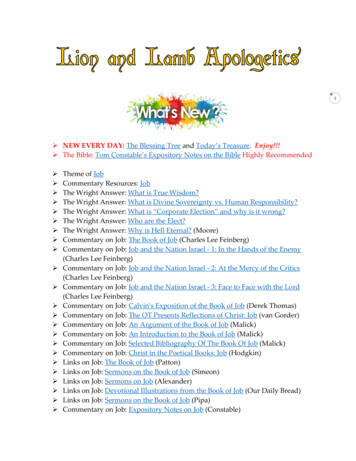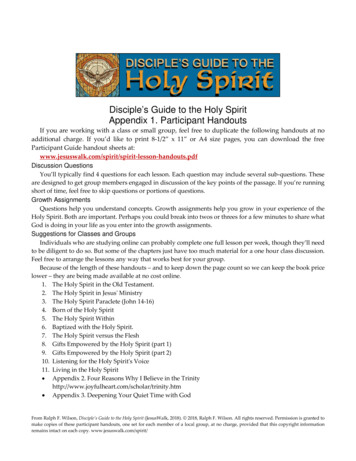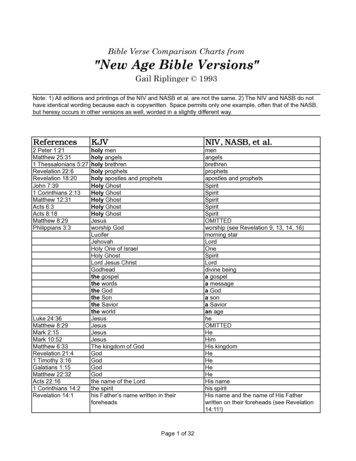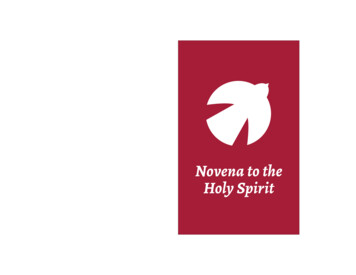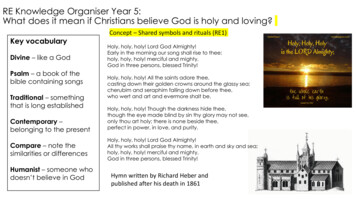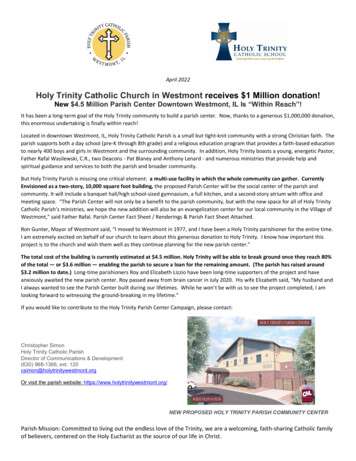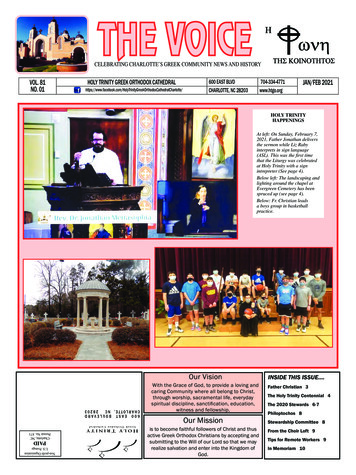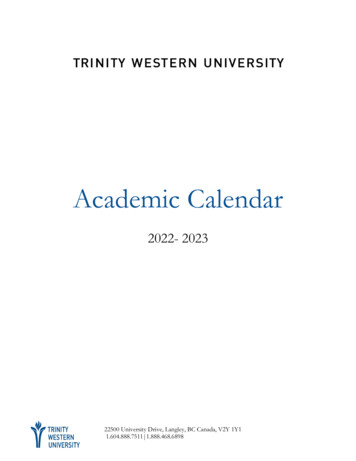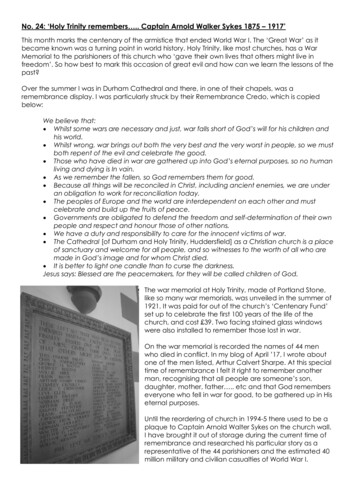
Transcription
No. 24: ‘Holy Trinity remembers . Captain Arnold Walker Sykes 1875 – 1917’This month marks the centenary of the armistice that ended World War I. The ‘Great War’ as itbecame known was a turning point in world history. Holy Trinity, like most churches, has a WarMemorial to the parishioners of this church who ‘gave their own lives that others might live infreedom’. So how best to mark this occasion of great evil and how can we learn the lessons of thepast?Over the summer I was in Durham Cathedral and there, in one of their chapels, was aremembrance display. I was particularly struck by their Remembrance Credo, which is copiedbelow:We believe that: Whilst some wars are necessary and just, war falls short of God’s will for his children andhis world. Whilst wrong, war brings out both the very best and the very worst in people, so we mustboth repent of the evil and celebrate the good. Those who have died in war are gathered up into God’s eternal purposes, so no humanliving and dying is In vain. As we remember the fallen, so God remembers them for good. Because all things will be reconciled in Christ, including ancient enemies, we are underan obligation to work for reconciliation today. The peoples of Europe and the world are interdependent on each other and mustcelebrate and build up the fruits of peace. Governments are obligated to defend the freedom and self-determination of their ownpeople and respect and honour those of other nations. We have a duty and responsibility to care for the innocent victims of war. The Cathedral [of Durham and Holy Trinity, Huddersfield] as a Christian church is a placeof sanctuary and welcome for all people, and so witnesses to the worth of all who aremade in God’s image and for whom Christ died. It is better to light one candle than to curse the darkness.Jesus says: Blessed are the peacemakers, for they will be called children of God.The war memorial at Holy Trinity, made of Portland Stone,like so many war memorials, was unveiled in the summer of1921. It was paid for out of the church’s ‘Centenary Fund’set up to celebrate the first 100 years of the life of thechurch, and cost 39. Two facing stained glass windowswere also installed to remember those lost in war.On the war memorial is recorded the names of 44 menwho died in conflict. In my blog of April ’17, I wrote aboutone of the men listed, Arthur Calvert Sharpe. At this specialtime of remembrance I felt it right to remember anotherman, recognising that all people are someone’s son,daughter, mother, father . etc and that God rememberseveryone who fell in war for good, to be gathered up in Hiseternal purposes.Until the reordering of church in 1994-5 there used to be aplaque to Captain Arnold Walter Sykes on the church wall.I have brought it out of storage during the current time ofremembrance and researched his particular story as arepresentative of the 44 parishioners and the estimated 40million military and civilian casualties of World War I.
The plaque states Captain Arnold WalkerSykes home being Netherleigh,Huddersfield. This house is No. 77 NewNorth Road and is shown in thephotograph below. The plaque alsostates that he is buried at Bedford HouseCemetery at Zillebeke, just outside Ypresin Belgium.Sykes was killed in the Battle ofPasschendaele on Sept 30th 1917. TheBedford House Cemetery was nearby towhere he died. It was the site of ChâteauRosendal which was used in the war as amilitary headquarters and renamedBedford House before being destroyedby enemy action. A remaining part of themoat can be seen in the photo to theright. The cemetery has over 5000 graves.Sykes was a Captain of the 9th Battalionof the York & Lancaster Regiment. Hehad been posted to Zillebeke in June1917 and hisregiment was visitedby King George V onJuly 4th.Bedford House Cemetery, ZillebekeOne of the privates in the 9th Battalion was Henry Lamin, whose letters homehave been compiled into a book detailing daily life in the trenches. Laminserved under Captain Sykes and documented the time in the summer of1917 during the Battle of Passchendaele.The book mentions that the 9th Battalion moved back into battle on June 26that a place known as Hedge Street. In the first 4 days of battle, Harry Laminmade reference to the situation being “normal”, as during these 4 days the
9th suffered 5 deaths and 13 wounded, and the word “normal” referred to an expected rate ofcasulties for a battalion due to shelling, sniper fire or venturing into no-mans-land.The following description from Lamin’s diary describes the fighting that took place atPasschendaele a couple of days before Sykes was killled:Early this morning the enemy heavily bombarded our positions between ‘Tower Hamlets’and ‘Polygon Wood’, and subsequently launched three attacks, all of which were repulsedwith loss. The first attack, delivered south of the Reutelbeek, was beaten off by our firebefore reaching our position. Shortly afterwardshostile infantry advanced astride the YpresMenin road under cover of a thick smokebarrage and accompanied by Flammenwerfer[flame-thrower] detachments, and succeededtemporarily in driving in one of our advancedposts. An immediate counter-attack by ourtroops recaptured the post together with anumber of prisoners and machine-guns. Later;in the morning an attempt to repeat this attackwas broken up by our artillery fire.This card was sent home by Lamin at the end of thebattle. The image was drawn by an Army Officer – J.V.Breffit. In the message on the reverse Lamincommented ‘the captain got killed a jolly goodfellow too’. Sykes was in temporary command of ‘C’Company, having been actually posted to ‘A’Company and was the only officer killed on thatparticular tour in the front line.From letters which have been received it is clear that thedeath of Captain Arnold Sykes has cast a gloom over thewhole of the regiment to which he belonged. He was killedinstantly by a German bomb, and in the words of one writer“Died a glorious death repelling an attack by the enemy.”The officer commanding the battalion writes “For a man ofhis years he was wonderful, and such an excellent exampleto all the officers of the battalion. He was always socheerful, keen and thoughtful for others and I can assureyou that none in the battalion will be missed more thanCaptain Sykes.”He has been buried in a cemetery well behind the line anda cross placed over his grave.This article aboutCaptain Sykes deathappeared a coupleof weeks later in theHuddersfield DailyExaminer on FridayOctober 17th 1917.Pictured below onthe following page isa prayer cardproduced by HolyTrinity earlier in thewar, listing all theparishioners onactive service. At thisstage Sykes is listedas serving inPontefract Barracks.There are 63 menlisted in activeservice and 9 hadbeen killed. Thenumber in service willalmost certainlyhave risen by 1918.
I decided to research further into Arnold’s life before the war. The 1911 census shows him livingwith his wife, Mary, 3 children and 3 servants at ‘Netherleigh’, aged 35. A photograph ofNetherleigh is shown on p2. His occupation was listed as a worsted cloth manufacturer andemployer.Arnold had married Mary Ambler at Halifax Parish Church (now the Minster) on June 27th 1900. Thecensus also listed Mary’s father as a worsted spinner and employer. The young couple lived withMary’s parents at ‘Glen Royd’ in Warley, Halifax before moving to ‘Netherleigh’.
Arnold’s father, John Henry Sykes, was also a woollen manufacturer and cotton spinner andowned Gosport Mills in Outlane. The family home was ‘Bryancliffe’ (now renamed with its originalname, ‘Laurel Bank’) on Hungerford Road.The Sykes family were almost certainly part of, what David Griffiths in ‘The Villas of Edgerton’describes as, “the well-known industrial dynasty”. The Sykes’s ran a number of local textile millsincluding Acre Mills in Lindley. There is a photo of ‘Laurel Bank’ in David Griffith’s book.The 1881 census recorded John Henry Sykes as employing 380 ‘hands’. His business had clearlygrown from 1871 when he was listed as employing 72 men, 56 boys and 68 girls. The 1881 and 1871censuses have the Sykes family address as being West Place on Trinity Street, in what is now theHighfield Funeral Home. Arnold Sykes was born at West Place and baptised at Holy Trinity onAugust 12th 1875. He was the youngest of five children.I was intrigued by the address being West Place as I knew this to be the home of Sarah Allen, thewidow of John Allen, who was the brother of the church’s founder Benjamin Haigh Allen.The 1871 census has West Place listed as 5 separate homes, so presumably it had been divided upinto smaller houses after being built or perhaps was always designed as a number of dwellings.There were 30 people living in West Place in the 1871 census.In 1881 Arnold is listed as living with his parents, together with his father’s sister, his brother Edward(8) and sister Florence (11). Another of Arnold’s sisters had died in childhood. His older sister Edithwas not listed and may have been away at school. The 1891 census shows the family hadpurchased ‘Bryancliffe’ on Hungerford Road, and Arnold had been sent off to Uppingham Schoolin Rutland. These pieces of evidence suggest the family textile business must have continued togrow. The family also had 4 servants.Initially I expected Arnold Walker Sykes to be a fairly ordinary man and chose him as a singlerepresentative of the 44 parishioners listed on the church’s war memorial. I suspected that as aslightly older man, serving as a Captain and with a plaque in church to remember him, that hemight be a little more privileged than some listed. Finding his home on New North Road to be afairly ordinary sized dwelling didn’t prepare me for his story linking right back to the foundation ofHoly Trinity and the growth of the town’s textile industry.Captain Sykes never got to see his 3 children grow up or his business flourish. On his death, thebusiness was passed onto his wife and brother, who also inherited his father’s business when hedied two years later. As an officer Arnold Sykes could have expected to be protected from the fullhorrors of trench warfare and yet he was one of relatively few who died with the men theycommanded. From the accounts of those men it seems he was sorely missed in the battlefield aswell as at home. The inscription on our war memorial ‘they left all that was dear to them, endured
hardness, faced dangers and finally passed out of the sight of men, giving their own lives thatothers might live in freedom’, seems totally appropriate wording for Captain Sykes. May we, in ourtime, never forget that sacrifice or abuse that hard-fought freedom.Although Captain Sykes was privileged and by chance, his war-time story better documentedthan most, all 44 local men and 40 million worldwide who died in the ‘Great War’ plus the manymillions in other conflicts, are important to their own families and also to God. I pray that the ‘warto end all wars’ as it became known, which of course we know it wasn’t, should never berepeated and ask God for an end to all the current conflicts; that all humanity may live togetherin peace and share the earth’s resources fairly.1914 - LEST WE FORGET - 1919Footnote:Thanks to my Dad for researching the censuses and other archives online for use in this month’sblog. Through his research around this topic I discovered my Great-Grandfather also fought atPasschendaele (and survived the war). I also learnt that the vicar of my childhood parishpropagated poppies that helped persuade Earl Haig to adopt the poppy as the symbol ofremembrance of the War. The bright red Flanders Poppies had thrived on the battlefields of Ypresdespite all the fighting.“WE SHALL KEEP THE FAITH”Oh! Ye who sleep in Flanders Fields,sleep sweet - to rise anew!We caught the torch you threwand holding high, we keep the Faithwith all who died.We cherish, too, the poppy redthat grows on fields where valour led;it seems to signal to the skiesthat blood of heroes never dies,but lends a lustre to the redof the flower that blooms above the deadin Flanders Fields.And now the torch and poppy redwe wear in honour of our dead.Fear not that ye have died for naught;we'll teach the lesson that ye wroughtin Flanders Fields.Moina Michael 1918, inspired by ‘In Flanders Fields’ by Lt Col John McCraeAndy BarberNovember ‘18References:The Dean & Chapter, Durham Cathedral for use of the Remembrance Credo.Bill Lamin: Letters from the Trenches: A solder of the Great War. Michael O’Mara Books Ltd 2009Huddersfield Daily Examiner, Oct 17th 1917 online via British Newspaper ArchiveDavid Griffiths: The Villas of Edgerton. Hudds Civic Soc. y-ieper-belgium-2/http://www.ancestry.com – census records for 1871-1911 & National Probate hael-we-shall-keep-faith.htm
His business had clearly grown from 1871 when he was listed as employing 72 men, 56 boys and 68 girls. The 1881 and 1871 censuses have the Sykes family address as being West Place on Trinity Street, in what is now the Highfield Funeral Home. Arnold Sykes was born at West Place and baptised at Holy Trinity on August 12th 1875. He was the .
